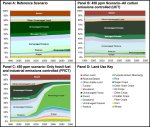Atmospher Sci & Global Chg
Research Highlights
June 2009
Terrestrial CO2 Economically Important in Greenhouse Gas Control
Policies protecting forests could lower costs of cutting atmospheric carbon dioxide, Science article says

Without a universal carbon tax, there’s more incentive to use land for bioenergy crops (panel C) than for food and fiber crops (panels A and B). Enlarge Image.
Results: According to a study by the Joint Global Change Research Institute, failing to include land use changes in policies to stabilize greenhouse gases in the atmosphere could lead to massive deforestation and higher costs for limiting carbon emissions. The study results, which appeared in the May 29 issue of Science, also suggest improved agricultural technology will be as important as new energy technology in a carbon-limited future.
Why it matters: We typically think of carbon dioxide emissions as coming from industrial or fossil fuel sources. But another source is from the earth itself-from land use practices such as deforestation. And oddly, steps being taken to decrease emissions from the first two sources could actually increase terrestrial carbon emissions globally.
Why? Because policies that promote the use of dedicated biomass crops divert land that would otherwise be left for food and fiber crops, forests and unmanaged ecosystems. This land use shift releases excess CO2 into the air just as industrial activities and the burning of fossil fuels do. But whether policies to stabilize greenhouse gases in the atmosphere should include this terrestrial source of CO2 is under debate.
"When society tries to limit carbon dioxide concentrations, if terrestrial carbon emissions aren't valued but fossil fuel and industrial emissions are, economic forces could create very strong pressures to deforest," said Pacific Northwest National Laboratory engineer Marshall Wise. Wise led the study, which was done by researchers with the Joint Global Change Research Institute in College Park, MD, collaboration between PNNL and the University of Maryland.
Methods: To understand the effects of economic forces from climate policy on terrestrial carbon and land use changes, the researchers used the MiniCAM, an integrated assessment model developed by the PNNL team over the last two decades, to compare different scenarios. This model incorporates economics, energy, agriculture, land-use changes, emissions and concentrations of greenhouse gases to understand how human decisions interact with natural processes that control climate.
For this study, the researchers set a limit on the highest concentration that CO2 could reach. Then they compared two ways to stay within that limit: in one, they taxed terrestrial carbon emissions and industrial and fossil fuel emissions all at the same rate. In the other, they only taxed emissions from industry and fossil fuels.
Ignoring terrestrial carbon led to a nearly complete loss of unmanaged forests by 2100, largely because they were replaced by massive expansions of bioenergy crops that were planted to reduce the use of fossil fuels. However, placing a value on terrestrial carbon emissions led to increased forest cover, while bioenergy use still increased considerably compared to today.
In addition, the cost to reduce global emissions in a world that valued terrestrial, fossil fuel and industrial sources dropped to half that of the world in which only fossil fuel and industrial entities paid to emit carbon. This suggests that storing carbon in forests, agricultural areas, and other ecosystems is an important and cost-effective part of a bigger carbon dioxide emissions control strategy that includes dramatic changes to the global energy system.
What's Next: The PNNL team plans to further explore interactions between energy and land-use in alternative international mitigation architectures.
Acknowledgments: PNNL is transforming the nation's ability to predict climate change and its impacts. This study was funded by the U.S. Department of Energy's Office of Science and the Electric Power Research Institute. The research team includes Wise, Jae Edmonds, Katherine Calvin, Allison Thomson, Leon Clarke, Benjamin Bond-Lamberty, Ronald Sands, Steven J. Smith, and Anthony Janetos.
Reference: Wise MA, KV Calvin, AM Thomson, LE Clarke, RD Sands, SJ Smith, AC Janetos, and JA Edmonds. 2009. "Implications of Limiting CO2 Concentrations for Land Use and Energy." Science 324(5931):1183-1186. DOI: 10.1126/science.1168475. Press release.
